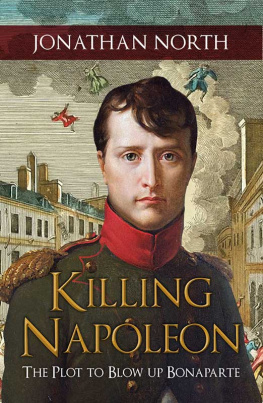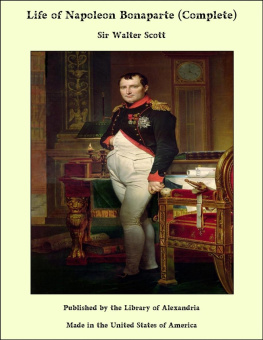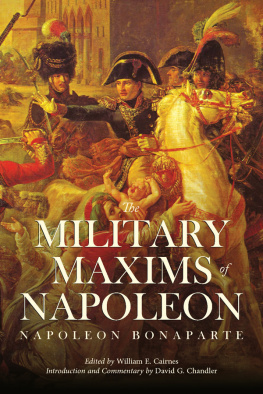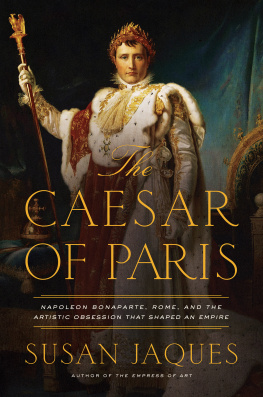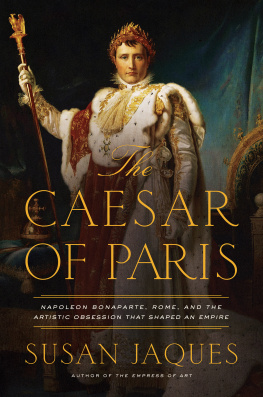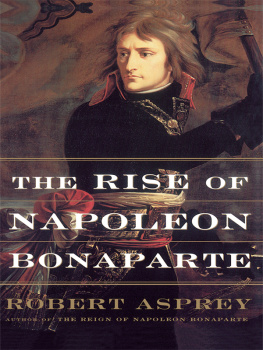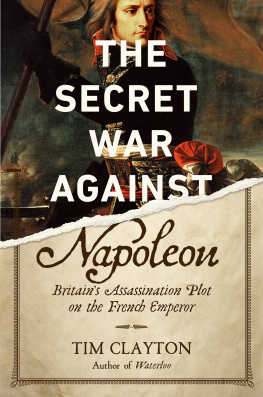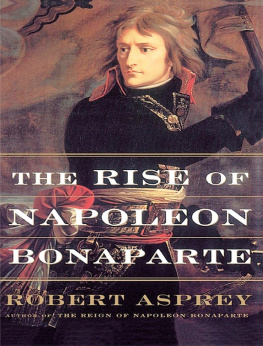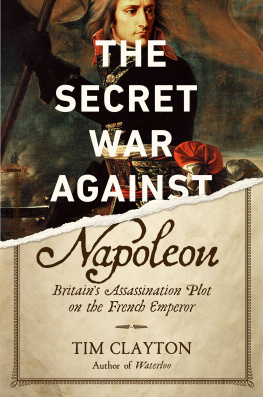First published 2019
Amberley Publishing
The Hill, Stroud
Gloucestershire, GL5 4EP
www.amberley-books.com
Copyright Jonathan North, 2019
The right of Jonathan North to be identified as the Author of this work has been asserted in accordance with the Copyrights, Designs and Patents Act 1988.
ISBN 9781445683768 (HARDBACK)
ISBN 9781445683775 (eBOOK)
All rights reserved. No part of this book may be reprinted or reproduced or utilised in any form or by any electronic, mechanical or other means, now known or hereafter invented, including photocopying and recording, or in any information storage or retrieval system, without the permission in writing from the Publishers.
British Library Cataloguing in Publication Data.
A catalogue record for this book is available from the British Library.
Origination by Amberley Publishing
Printed in the UK.
CONTENTS
LIST OF ILLUSTRATIONS AND MAPS
Illustrations
A heroic image of Napoleon, First Consul of France.
An image of Napoleon, mounted, dating from the time of the Infernal Machine.
Napoleon in uniform.
The British view of Napoleon and his fellow consuls.
The Minister of Justice, Joseph Fouch.
The Prefecture of Police.
The courtyard of the Prefecture of Police.
The Tuileries Palace.
A review before the Tuileries.
A row of houses in Rue Nicaise.
The street itself.
A map of the Rue Nicaise.
A crowd before the theatre.
An artists impression of the explosion.
A and B. Two contemporary versions of the explosion, produced by the French media.
A and B. Two portraits of the Comte DArtois, arch-enemy of Napoleon.
Georges Cadoudal an unflattering portrait.
Cadoudal as his supporters saw him.
The capture of Cadoudal.
Saint-Rjant, the man who lit the fuse.
Coster-Saint-Victor, another of the conspirators.
A Breton gentleman in Paris.
A Breton gentleman at war.
Louis de Frott.
The Jacobins get the blame.
The bust of Napoleon by Ceracchi.
Maps
The area around Paris in 1800.
Central Paris in 1800.
The Tuileries in 1800.
The Prefecture of Police.
ACKNOWLEDGEMENTS
I would like to thank Steven H. Smith for providing me with countless texts. I also owe a debt of thanks to the staff of the National Library of Scotland; the British Library; the London Library; Dr Clare Lappin of the Warburg Institute; Peter Harrington of the Anne S. K. Brown Military Collection; Isabelle Rossez of the Service de la Mmoire et des Affaires Culturelles at the Prfecture de police in Paris; the Archives de Paris; the Bibliothque Historique de la Ville de Paris; and the Archives Nationales. Incidentally, the Museum of the Prefecture of Police in Paris is also worth a visit. It has on display a collection of prints and documents relating to the Infernal Machine, and the rebel Georges Cadoudals wallet, but there is little in the way of police evidence relating to the actual bomb, as most has been lost or destroyed over the years.
I would also like to thank participants at the Napoleon Series forum, in particular Daniel Lamblat, Susan Howard and Tom Holmberg, for all their assistance over the years, and the anonymous people who make the Bibliothque Nationale de Frances Gallica repository of rare texts such a splendid resource.
I am grateful to the professional team at Amberley, particularly Jonathan Jackson and Shaun Barrington, and would like to thank all those who commented on the manuscript and who provided advice. I am, however, responsible for any errors or lapses in continuity. The process of research, translation and writing has been one that has lasted many years, something which has caused a physical and mental absence from family life. For that I owe a great debt to Evgenia and Alexander for their forbearance. It may be a poor consolation, but I hope to pay some of that debt out of the royalties.
AUTHORS NOTE
Translations within the text are my own and, in most cases, I have converted dates to the more familiar Gregorian style (there is a helpful converter at www.17891815.com/cal_conc.htm). Most contemporary writers, aside from the royalists, followed the republican calendar, but there was much confusion about days off, holidays and the starting and ending of years.
Confusion reigned, too, when it came to currencies. It may be worth bearing in mind that, roughly speaking, an cu was worth 5 Francs or 100 sous and a Louis was worth 20 Francs (and a Pound Sterling was worth around 25 Francs). As for purchasing power, Andr Guilmot, a frugal medical officer, baulked at paying three sous to have his shirt washed and two more to have it ironed, albeit badly. The more prodigal Chevalier de Mautort calculated that he could live modestly in the Paris of 1800 on 20 cus per month, including rent and food (with a decent meal costing 24 sous), although many a labourer was having to live off 20 sous a day.
If currencies continued to be referred to with a mixture of the old and new styles, then it should come as no surprise that a similar situation pertained with weights and measures and street names. Rue Nicaise was relatively easy for Parisians, as it was a simple shortening from Rue Saint-Nicaise. Other streets in that quarter had, however, been transformed into more revolutionary-sounding thoroughfares. Rue Rohan may have become Rue Marceau, and Rue de Chartres-Saint-Honor the Rue de Malte, but many of the locals continued to use the old names.
As many examples in this book will show, contemporaries also had problems when it came to spelling surnames. This led to puzzlement, and some cases of wrongful arrest. Forms of address also proved problematic. Although citoyen and citoyenne dominated in official documents, Monsieur and Madame were becoming increasingly common in everyday speech under the Consulate and, indeed, some of the older forms of address, based on pre-revolutionary hierarchies, were creeping back into use. In 1800, when asked how he should prefer to be addressed, the Bishop of Coutances remarked, As Monsieur in public, but, in private, one may call me Monseigneur.
Map 1. The area around Paris. This shows how contained Paris was within its ancient walls.
Map 2. Central Paris.
A Rue dAguesseau
B Rue Paradis Poissonnire
C 310 Rue Martin (Carbons house)
D Rue Neuve Egalit
E Place des Victoires
F The Opera, or Thtre des Arts et de la Rpublique, on Rue de la Loi
G Rue Croix des Petits Champs
H Hotel de Mayenne in Rue du Four-Saint-Honor
I Rue des Prouvaires
J The Louvre Museum
K Rue Nicaise
L The Tuileries Palace
Map 3. The area around the Tuileries. This plan shows projected modifications to the citys streets but gives a good view of the layout as it was in 1800. Napoleons coach exited the Tuileries gates, then crossed the square into the Rue Nicaise.

